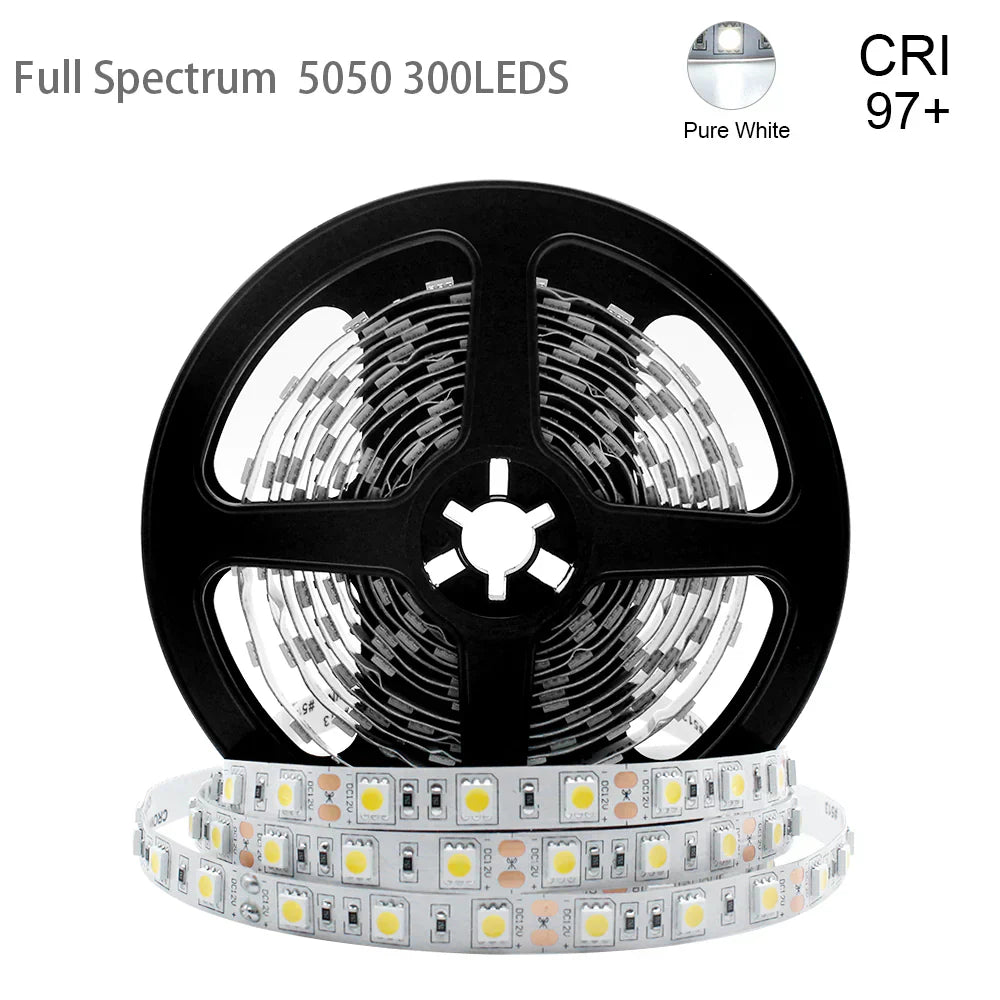In the modern lighting industry, terms like high color rendering, natural light quality, and visual comfort have become essential benchmarks for evaluating illumination performance. As lighting evolves from simply being “bright enough” to “visually authentic,” Full Spectrum LED Strips have emerged as a leading innovation.
These advanced LED strips go beyond brightness — they deliver a natural, sunlight-like light that enhances how we see and experience colors. This article explores the key technical principles behind full spectrum lighting, including CRI (Color Rendering Index), spectrum coverage, and true-color performance, revealing why this technology is redefining LED illumination.
1. What Are Full Spectrum LED Strips?
“Full spectrum” refers to light sources that emit across nearly the entire visible wavelength range, closely replicating the balanced and continuous spectrum of natural sunlight.
Conventional LED lights, which rely on blue chips and phosphor coatings, often suffer from deficiencies in the red and deep blue regions, causing unnatural tones or “cool” lighting effects.
Full spectrum LEDs, however, use enhanced phosphor formulations and multi-chip architectures to achieve uniform energy distribution between 400nm–780nm, resulting in light that looks more natural and performs more consistently across all colors.
2. CRI and the Science of True-Color Rendering
What Is CRI?
The Color Rendering Index (CRI) measures how accurately a light source reproduces the natural colors of an object compared to sunlight.
-
CRI < 70: Colors appear distorted or flat; suitable only for basic industrial lighting.
-
CRI ≈ 80: Acceptable for general commercial and residential use.
-
CRI ≥ 90: High color fidelity; true-to-life representation.
-
CRI ≥ 95: Near-natural performance for photography, healthcare, or art applications.
Full Spectrum LED Strips often reach CRI 95–98, allowing for richer hues, realistic skin tones, and better contrast — without the washed-out or artificial feel common in traditional white LEDs.
3. Spectrum Coverage: The Key to Natural Illumination
Sunlight’s continuous spectrum provides smooth energy distribution across all wavelengths, including red, green, and blue bands. Standard LEDs, in contrast, typically exhibit spectrum “gaps,” especially in the red region (600–700nm) — leading to cooler tones and muted warmth.
Full spectrum LEDs correct this by using multi-emitter chip designs and broadband phosphor coatings that fill these spectral valleys. This enables light that not only appears balanced but also enhances color contrast, depth, and realism.
The result? Illumination that mimics sunlight’s visual comfort — ideal for both everyday and professional environments.
4. Key Advantages of Full Spectrum LED Strips
1. True-to-Life Color Reproduction
Perfect for photography, art studios, retail displays, and homes — full spectrum lighting reveals authentic tones, textures, and details. Reds are vibrant, skin tones are natural, and every hue appears as intended.
2. Reduced Eye Strain and Blue Light Fatigue
With smoother spectral distribution and lower blue-peak intensity, these strips minimize visual fatigue, making them suitable for offices, study spaces, and long-hour environments.
3. Enhanced Aesthetics and Material Definition
Full spectrum lighting elevates the visual impact of architectural spaces and products, highlighting material texture and color accuracy for a premium ambiance.
4. High Efficiency and Long Lifespan
Advanced thermal management and chip design ensure high luminous efficacy without compromising reliability — maintaining stable performance over extended operation.
5. Full Spectrum vs. Standard High-CRI LEDs
|
Feature |
Standard High-CRI LED Strip |
Full Spectrum LED Strip |
|
CRI |
Around 90 |
≥95 (up to 98) |
|
Spectrum Continuity |
Partial, missing red region |
Continuous, no major spectral gaps |
|
Color Accuracy |
Good, slightly cool |
Excellent, near-natural daylight |
|
Visual Comfort |
Slight blue shift |
Balanced, eye-friendly |
|
Applications |
General lighting |
Professional and high-fidelity lighting |
In short, full spectrum LEDs are not just about higher CRI — they deliver balanced energy distribution and superior visual comfort, setting a new benchmark for realistic illumination.
6. Ideal Applications
-
Photography & Videography Studios – Capture accurate skin tones and true hues.
-
Art Galleries & Museums – Reveal fine details without color distortion.
-
Premium Residential Lighting – Create warm, natural environments.
-
Medical & Laboratory Use – Enhance precision through true-color visibility.
7. Recommended Products
Below are some of our most popular Full Spectrum LED Strip models, designed for high-performance applications in both residential and commercial lighting:
|
Product Name |
Key Features |
Link |
|
Full Spectrum LED Strip Light CRI96 SMD5050 300 LEDs (24V, 12W/m) |
High-efficiency SMD5050 chips, wide-spectrum output, excellent color fidelity |
|
|
Full Spectrum LED Strip Light CRI96 SMD2835 300 LEDs (24V, 10W/m) |
High-CRI SMD2835 chips, IP00/IP67 options, ideal for indoor/outdoor projects |
|
|
Full Spectrum LED Strip Light CRI96 SMD2835 600 LEDs (24V, 16W/m) |
Ultra-dense LED configuration for smooth, shadow-free illumination |
8. Conclusion
Full Spectrum LED Strips represent a major step forward in lighting evolution — from efficiency and longevity to visual accuracy and well-being. By bridging the gap between artificial and natural light, they deliver illumination that’s both powerful and comfortable.
Whether you’re designing a professional workspace, a creative studio, or simply seeking to enhance your home’s ambiance, Full Spectrum LED Strips provide the truest, healthiest light possible — capturing the beauty of sunlight in every detail.

